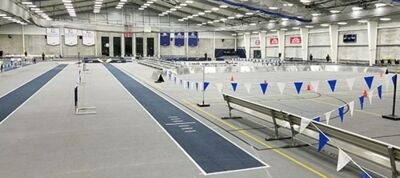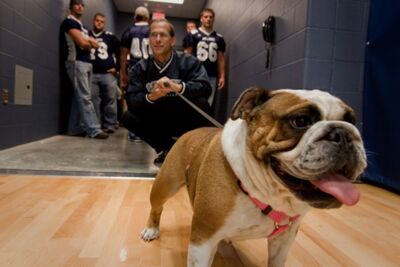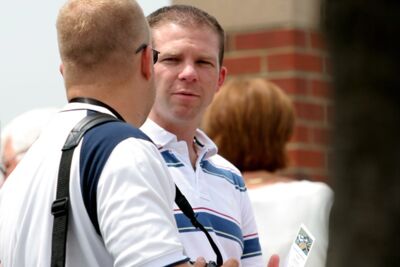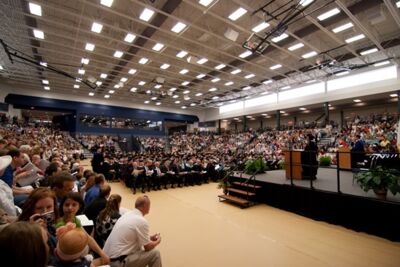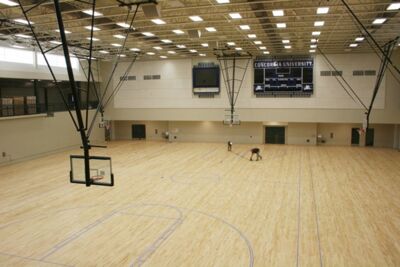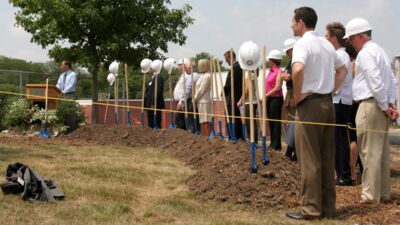
Ten years after the bulk of the building was completed, the Walz Health and Human Performance Complex remains a game changer on the Concordia University campus. The facility has set the stage for major events such as graduation, GPAC championship contests, physical education courses and for memories that will forever live within the minds of coaches, students, staff, community members and fans who have experienced it. So much has happened in 10 years and yet, the Walz Complex glistens as if it were brand new.
Growth for athletics and for the university as a whole has depended upon enhancements such as the Walz Complex. Those intimately involved in the process of fundraising and in seeing out the completion of the Walz Complex provided insight, facts, figures, memories and anecdotes in regards to what it took to make the facility a reality. They tell of a story that is not just about bricks and mortar, but about people who care deeply for God, for each other and for Concordia. This is Walz at 10.
I. In need of an upgrade
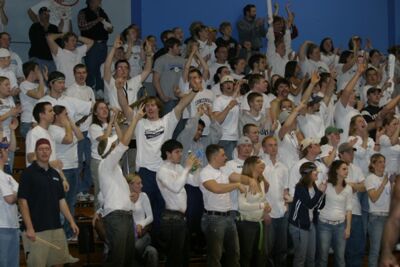
Rev. Dr. Orville Walz, former Concordia President: I came to Concordia as a freshman in 1957. At that time on campus we had what we referred to then as the ‘Old Gym,’ which of course is no longer around. It was located somewhere around where the Thom Leadership Education Center is now. That Old Gym did not allow you to run laps when you tried to work out. The only place you could really run was on the east side of the gym on the second floor … Then in the late ‘50s while I was still a student, the Lutheran Church Missouri Synod had a plan to build a new gymnasium at Concordia. The problem was what was needed was more expensive than the funds that were available. That’s why we ended up with what we called the ‘New Gym.’
Dr. Kregg Einspahr, former Cross Country/Track & Field Head Coach: The need for this was clear all the way back when I was a student here. I started in 1978 as a student. At that time, Coach Fred Beile down at Doane College allowed Concordia to come to Doane’s fieldhouse facility and train twice a week. They got to the point with all of their sporting needs that they couldn’t continue to do that past about 1990 … It’s really difficult to have a college track team without indoor facilities. For a while we were able to go into the Devaney Center in Lincoln in the evenings while tennis was practicing. We were able to do that once or twice a week for two years. The need was clear back in the 1970s already.
Grant Schmidt, former Director of Athletics/Men’s Basketball Head Coach: The reality hit when Concordia realized that athletics could be a great avenue to increase student population. Our state of facilities really limited our ability to increase the size of rosters and increase the amount of sports that we offered. We lacked academic majors and academic programs in health and physical education. We couldn’t even offer certain academic opportunities for students to be involved in. We were stuck with the PE Gymnasium that was built in 1961. It had basically four locker rooms, no weight room and only one classroom.
Dave Kumm, current Chief Financial Officer: You can imagine trying to run our entire athletic program in just the PE Building and then you consider there was a big swimming pool that took up a lot of that space. We knew we had to do something. It was critical to recruitment and the growth of our athletics.
Rev. Dr. Brian Friedrich, current President and CEO: There was a commencement and it rained cats and dogs. It just poured. Everyone had to dress and line up in the facility. At the same time, water is just leaking in out of that foyer area. For many, many years the (PE Center) gym was the largest facility in the city of Seward. We would host graduation, not just for Concordia but the Seward community. One year for the Seward High School commencement, the fire Marshall was there. The next week he calls President Walz and says there were too many people in the gym. You’re going to have to fix this. In a gym that already had limited seating, we had to cut a door into the north side of the building and split the bleachers in half. That was not a fun memory.
Pete Kenow, current Advancement Officer and former Vice President of Advancement: Concordia athletically was actually doing very well. We had really competitive teams. We had great coaches and the success of the athletic programs was in spite of our facilities. When students came to Concordia, in order for our coaches to recruit the best students, they had to sell the program, they had to sell relationships and they had to sell being competitive. They had to overcome our facilities. It was a tough recruitment road for the admissions staff and the coaches. That was one of the big challenges that we had.
II. A trip down memory lane
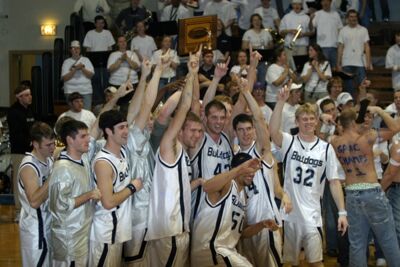
So what was life like before the Walz Complex existed? Many still have fond memories of the cramped PE Center Gym that is associated with Concordia’s rise to prominence in basketball.
Friedrich: There are so many great memories from the old gym (PE Center). I don’t know if it was a conference final game, but we were playing Doane and these kids from Doane brought in two-by-fours and they were using them as noise makers. They were just smashing them on those old wooden bleachers and little pieces of wood were flying out. We had to bring in security to get them taken away and stop that.
One of my other memories was when we played Chadron State and Devin (Smith) I think was a senior. They had this guy that the fans all called Cowboy when he came in. He was a huge guy. At one point in the game Devin comes down and just jams it over this guy. The crowd goes crazy wild.
It reached its zenith when we could only give students two tickets (for graduation). We would get calls from grandparents. “What do you mean I can’t come? I helped fund my grandchild’s entire education. What do you mean I can’t come?” That was a rough one. There were games where they had to shut them off. Many times because of how intense the game was and the crowd size, we brought in security. It was long before the days of all those security threats. It was just because of building codes and the intensity of the games.
Devin Smith, current Director of Athletics: During that time (before Walz) you had to be more collaborative and work together more. You had to have more understanding of what each program wanted to do, but at that time there weren’t as many offseason programs that were so enhanced. Since then sports have become year-round. You’re chasing this industry that was really starting to explode at the NAIA and lower levels of the NCAA to match the experience of what NCAA Division I was doing already … Thinking back, our locker rooms were not that sweet. Our gym wasn’t sweet, but we made it our own. We had a pretty special feel in there for big-time rivalry games. Now when we have those matchups or those indoor track festivals you just go, “Wow.” Then you hear alums come back and say this is amazing. I feel that.
Schmidt: We had an AD, an assistant AD and one secretary and we shared a pretty small space. We had no place to put the staff. They had to move into other buildings. We still only had one classroom. We were busting at the seams with locker room space and had no opportunity for students to use the facility at all. Our teams were growing. It was just very frustrating. We were having an awful lot of success and doing it despite our facilities. I spent so many years apologizing for our facilities and always making excuses for our facilities. Once that was built in 2009, the first thing we talked about was our facilities. It used to be in the 90s we tried to do as little talking as we could about our facilities.
What a difference though. We had such a reputation for teams coming to Concordia and being so upset with the facilities that we had to put them in. That was a big advantage for us because it put our opponents in a crummy mood and it distracted them. Unfortunately, not only was the new facility a plus for us but it excited and pumped up our opponents as well. Now they were excited to come and eager to be part of our new facility. It used to be they hated coming to us because of that environment. It took a little getting used to. It was easy in the old PE building to fill it up. We had plenty of playoff games where the fire Marshall would have to close the door and not allow people in.
Drew Olson, current Women’s Basketball Head Coach: I love the old building. I got to play in there and had some incredible memories and moments as a player there. As a coach, there were some hilarious things. It was mostly positive. I’ll never forget the GPAC championship game where we beat Dordt in overtime. It’s probably now the second greatest basketball moment I’ve had (after winning the national championship). It was a phenomenal game, incredible atmosphere – something I’ll never forget. It was really special because my mom, dad and brother were at the game. Then as a coach, there were some good times like winning CIT there. We had all kinds of things going wrong with the building. The shot clock malfunctioned and we had scoreboard issues. There was one game where the scoreboard wasn’t working and it was right before our game was about to start. Somebody called buildings and grounds. The National Anthem is about to be played and this guy is working on the scoreboard during the Anthem. At the same time, the National Anthem was being played by the band and it was not good. It was an embarrassing moment. It was like, this is who we are now. To make it even worse, the shot clock wasn’t working. Pastor Bo (Wesley Baumeister), who was our chaplain at the time, was doing PA. He was doing a hand-held shot clock and every time it got to five he would have to announce it on the microphone, 5-4-3-2-1. It was so bad – but I loved the old gym. It was a huge home court advantage, but a new gym was definitely something that was needed. From a recruiting standpoint, it was hard to recruit to, and we just had all kinds of other issues. It was definitely needed.
Einspahr: It is awful hard to have a complete track team at the college level without an indoor facility in the kind of weather we have here. It’s one thing if you’re in Texas or Florida or Louisiana. In the middle of winter here, you have nowhere to train. We tried for a lot of years to do many different things. We called it adaptive track and field. At one point we had people training down at the ag pavilion – pole vaulters down there and throwers down there at different times. We used the old maintenance shed behind David Dorm for some sprint drills and some throws stuff. It was really limited what we could do. It was really tough on jumpers. They had no place to go. It influenced the way we recruited at that time.
Walz: I remember a Hastings College women’s basketball player saying how they hated to come and play at Concordia in that gymnasium that seemed smaller than some high school gymnasiums she had played in.
III. Planning and Fundraising
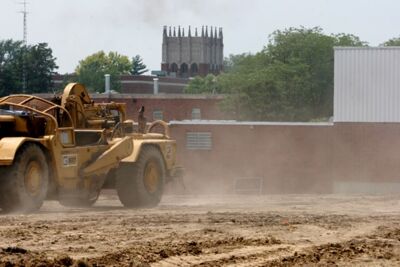
Kumm: BCDM did an initial drawing (of Walz) for the university. I’m not sure exactly when that was. It must have been in 2001 or 2002. It was on the radar screen. That was before my time here. I came in January 2003. I didn’t really hear a whole lot about it my initial year because I was busy fixing a lot of other things that needed to be fixed. My background was totally in accounting and finance. Construction, buildings and facilities were not my expertise. Luckily we had a guy by the name of Mel Varner who was here back then. He did a lot of the facilities. I learned a lot from him in regards to what needed to be done. My first master facility plan was in 2004. Once we get a master facility plan we get it approved by the LCMS folks and that gives us a little more freedom to move forward. That’s when it was placed in that zero to five (years) range.
Kenow: I started as VP in 2004. At that time the campaign was a year old already. The plans were already in place. It was pretty much dive-right-in, trial-by-fire. It was a comprehensive campaign that included dollars for the Walz Complex endowment and then Concordia fund. We had just kicked it off and there was a volunteer committee involved to help with the design aspects. The design and look of the building evolved and changed over time.
It was a different campaign in that we did not have a quiet phase. When we began raising funds for the building we were pretty much approaching everybody all at the same time. It was a very public campaign. We did not have one large lead gift. By the time the campaign was over, the largest gifts to the Walz complex were a $1 million and we had three of those. It was involving many people for quite a few years to get the fundraising to the point where we called it done.
Fred Ohlde, Fundraising Co-Chair for Walz project: I was approached by Orville and Brian about heading up fundraising. I was willing to give some overall leadership and work with a staff of people to make this happen. It was a very daunting task and I was somewhat overwhelmed. I did not have previous experience with this type of thing. As a result, I agreed to take it on, but I wasn’t going to do it alone. That’s how we ended up with co-leaders in Dennis Meyer and Doug Tewes. Both were very dynamic and gifted. We set this up in 2002 or 2003 and it took about six years. We had a downturn in the economy during this time and it made it a real challenge. I believe this was the largest project Concordia had ever undertaken in terms of size and cost at the time.
Smith: The buzz started in the ‘90s when I was here as an assistant athletic director in charge of game management, facilities and sports information. There was already a committee in place with plans and processes to dream up a design for what we wanted it to look like here on this campus. Already in the mid-to-late ‘90s we were a bit behind a couple other schools in our conference like Northwestern and Nebraska Wesleyan. They had just built their nice facilities. They set the stage and everybody else who was trying to navigate the facilities arms race at our level and the impact it would create in the student-athlete experience and the ability to grow an athletic department with programs and more student-athletes. It was something that would bring the curb appeal to get a different level of student-athlete to visit.
Walz: I was only involved in the initial planning and the initial fundraising. I’ve been gone 15 years. Much of the planning and especially the fundraising was done by Brian (Friedrich) and his development staff and athletic staff. Please don’t write anything about Orv did this or Orv did that because I really deserve very little credit. In fact, somewhat humorously when the board of regents decided to stick the name Walz in front of it, one of my former roommates called me and said, “How come they’re naming that new building after Marilyn (Orville’s wife)?”
Friedrich: As we were going through this, we got to a point where we were stuck. We went to the Dunklau Foundation and asked if they would consider a gift to this project. They said, “Yeah, we will.” We knew the Dunklau Foundation loved challenge grants. What they decided to do was give us a chunk of $500,000 paid out over a number of years and a $500,000 challenge. That was the spark we needed to raise the funds that got us to a whole new level. That was one really important thing.
We came to a point in this project where we said, “Because it doesn’t appear we’re going to raise all of the money, maybe we should cut back. Maybe what we should do is not have a separate facility for the fieldhouse.” The reason we had planned that is we needed to have multiple venues. If we had everything in one place, we would have the same problem we had then. We wouldn’t have had the ability to do what we wanted and needed to be able to do. God bless Kregg Einspahr. He was resolved that we needed to have a free-standing fieldhouse with a track in it. I’ve often said since then, “Thanks, Kregg.” Without his insistence I think the board could have been swayed to say, “We don’t have the money to do that. Let’s not do that.” That whole facility is absolutely spectacular. I think the most important part of the facility is the fieldhouse for many, many reasons. It has expanded our capacity, the community can use it – it’s just tremendous. It makes the facility very, very unique.
Schmidt: It’s always time and money. The biggest hurdle is how much money we were going to pay. That was intimidating for Concordia University to be looking at. How are we going to get people to donate? How are we going to get this all paid for? What timelines are we going to have? The first hurdle is getting everyone on the same page and agreeing on things that would be included in the project. The biggest challenge was probably rationalizing why we needed so many locker rooms, why we needed so many classrooms and why we needed so many seats in the arena – just the size of it. Today I’m sure there are still not enough office spaces to put all the coaches in. The biggest hurdle was not only the opening in 2009 – or as we were hoping, sooner than that – but looking ahead 20 years later. Now we’re at 10 years later. We wanted to build it so we could allow for growth to continue so that this facility didn’t become too small for the future needs of Concordia.
Einspahr: I would get updates and it seemed like the timeline would get pushed further and further back. The money wasn’t always in place to do the things as early as we wanted. The idea for the fieldhouse didn’t just pop up. The need for it has been around. I think everyone was quite conscience of the need and what that could do for the campus … I think the color scheme came out really well. We tried to match the basketball arena scoreboard. We used that for the track surface color. The way the concrete gray matched the infield turned out well. The lighting is really good. We have a lot of natural light. Other coaches would come in and say, “Wow, this is just great.”
Kumm: On the schedule we had the facility on the master plan that got approved in 2005. I can’t remember the dates when the On-A-Mission campaign started. The On-A-Mission campaign was the campaign to fund what was called at the time, the Health and Human Performance Athletic Center. A lot of people called it the H-2-PAC, which President Friedrich didn’t like. After it was constructed it got the Walz name added to it. On-A-Mission started and then we went out and selected an architect. First we had to make sure we could get financing and get approval from the LCMS. We had it in our master facility plan. We had to start looking at financing options not knowing how much we were going to raise. Our campaign was for $18 million towards this project and we knew it was going to be more than that. We ended up having to put a presentation together for LCMS. Brian and I went forward to St. Louis and met with the financing folks and met with LCMS. There was a whole rationale document we had to put together. We did that in October 2006. We knew we probably weren’t going to be able to raise all the funds to get it going.
In 2006 we went and took the proposal forward. We had identified with architects various components that were important. We engaged Sinclair Hille and Ellerbe Becket out of Kansas City to help us with construction. We got approval to move forward with that because we had solidified our financing campaign. We put together a business plan that showed the financial benefits the project would give us by doing it. That was critical for LCMS. I remember the treasurer saying at the time, “Well then this is really a no-brainer.”
Dan Grasso, Lead Architect of Walz Complex (Sinclair Hille): The building design was intended to be built for the long term with durable materials while providing for open naturally lit spaces and a vibrant interior highlighting the Concordia Bulldog brand. I believe the project was roughly 18 months of construction. One of the primary challenges was deciding how to best phase the project to align with fund raising, which in the end, was fully realized.
Friedrich: The board and much of the campus community and our constituents bought into the concept that we want to do this because it will help the most students the most. It will also give us the capacity that we just don’t have at this point and time. One of the challenges in the fundraising was making sure people understood that it wasn’t just about athletics. We were constantly trying to shift the message away from a focus on athletics. It was about the capacity of the institution to serve students and grow into the future. In many ways it was tied to the strategic planning of growth. There was no way we would have the enrollment size we have today without the Walz Complex.
Ohlde: I was optimistic from day one. There were some hiccups along the way but there was never a doubt that we would get this done. We had to stick to it over a period of six or seven years. I can’t take a lot of credit. I felt like we (as a fundraising chairs) were more figureheads and cheerleaders. I live in Wisconsin and was on the board at the time. Big projects like this always came before the board. I would never underestimate the vision of Orville Walz and Brian Friedrich. This was their challenge to the community and to the board.
IV: Stories from behind the scenes
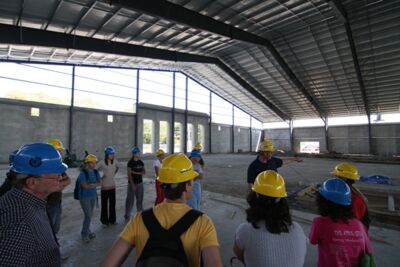
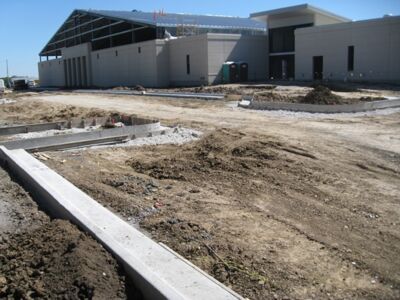
Friedrich: There was a lot of support for what was called at that time the Health and Human Performance Athletic Center – or the H-2-PAC. I remember one of my early conversations with a donor. President Walz and I were in Wisconsin. We approached him with just the initial designs of the facility. At that time it was called a wellness center. He said, “Yeah, I might be kind of interested in that, but I’d like to have more information.” We went back and got more detailed information and took it back to him. Finally he said to us, “I know what you’re talking about now. You’re talking about a gym.” Ed Steinbacher – I love that. He and his wife Lorraine were one of the first couples to make a leadership gift to the project.
The design of the building was first drawn on a napkin. We were talking to an architectural firm – BCDM. I think it might have been after lunch or a Bulldog Classic. This man named Dave Beringer who was a principal with BCDM took this napkin and made this little curve on it. The initial design really tried to incorporate that curve. It didn’t work out quite that way, but when you look at the pillars around the stadium that’s intended to reflect the original design of the building.
Kenow: The other great giving story that I remember is with the bulldog statue. As architects were designing that lobby space they came to Concordia and the architect said, “You know, this lobby space is going to have these lines that all come to the middle in the center, and it’s going to be a natural focal point right outside the door. Right now there is just not anything central there.” So we talked about it amongst our staff. Hastings has a bronco and all these people have these great mascots. We really need to have a bulldog. Of course it wasn’t in the budget. We were putting together a booklet for the campaign that we were going to send out to our donors for a mass mailing. It had the naming opportunities for spaces and equipment and all this stuff. At the last minute we added a bulldog statue. Nobody knew how much a statue was going to cost. We just took a number and plugged it in and sent it to print. We just thought there was no way anyone was going to make a gift for a bulldog statue in this amount. We sent it out and lo and behold one of the first naming gifts that came back was a gift for the bulldog statue (from Ray and Anita Hacker). It was almost like the dog that was chasing the truck and caught the bumper. Now what do you do? Now we have to go find someone and make a bulldog statue. We found an artist in Kansas City who specialized in dogs. We told him about what happened and what we were looking for and who we were. His first rendition came back with a bulldog on a stack of books to represent student-athletes. The top book was the Bible because we told him we were a Christian place. Well the dog has his paws on top of this stack of books – on top of the Bible. Our feedback was that’s not the right representation. We sent it back and he changed it and just made it books. Then we were real excited. He said, “Well here’s the computer model. Click on the buttons and you can do a virtual look-around.” The dog’s face was great, the muscles are rippling and everything and the back quarters looked good. Then we looked at the back end and we said, “Whoa! That’s a male bulldog!” We said, “That’s not going to work.” You can just imagine the kids (around the male bulldog statue). We sent it back again and told him it has to be a female bulldog. They finally send it back and we were like, “Yes, this is it!” The guy built it and shipped it in.
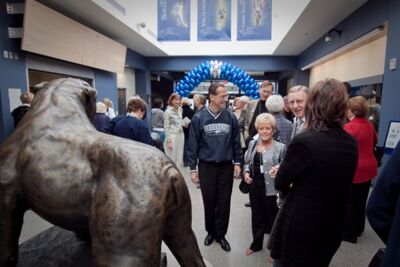
Schmidt: A lot of people thought that spending ‘X’ amount of thousands on a statue of a bulldog was maybe going over the top, but I think it speaks for itself now. It was a great addition to the hallway and the entryway to have that mascot in a beautiful molded statue that will forever be part of that. I’m proud of that. I don’t know how many thousands of pictures of athletes, alums and people visiting have been taken around that bulldog. It’s a signature quality.
I’m pretty sure it came out of Kansas City. We worked with him directly to get the right model and the right type of bulldog that really represented our image of a bulldog mascot. It became a questionable thing, but it was agreed upon because we got that completely donated by a separate donor. It became one of the more recognizable places on Concordia’s campus. I think most schools of similar size don’t necessarily have something like that that will ring on for years and years to come. I’m proud and very happy we followed through with that. There was talk about putting that outside, but for preservation and presentation I think it’s in the perfect location.
Friedrich: The other story was about a couple in which the wife had Nebraska roots. They had lived in Wyoming and they were back visiting her hometown in Nebraska and they decided to come to campus. They were walking around and they said they wanted to see the gym. There was a groundskeeper out walking around and says, “Yeah, I can show you the gym.” He took them to the gym and they got there and said, “No, we want to see the gym.” “This is the gym.” They had gotten some of the information about what we were doing to build this new complex and they said, “That can’t be the university gym. Oh my goodness.” They went home and over the course of time in this campaign they gave over a $1 million. They said, “You can’t operate what you’re doing with that kind of gym. That’s not a gym.”
Kenow: They had family in Valparaiso, Nebraska, and happened to drive through campus in Seward. Nobody was on campus. I don’t know if it was a weekend or a vacation or what. They walked up to the old PE Building and were looking through the window. Either security or a janitor let them in. I don’t think we even know to this day who that was but they deserve a raise. It probably was against all of our safety precautions today. They let them in. This couple introduced themselves and said they were just passing through. They knew it was a Lutheran school and thought they’d just take a look. This guy walked them around the PE Building and showed them the facilities and probably pointed out the good, the bad and the ugly. This couple was motivated to help. Throughout the years of the campaign, they just kept adding and adding and adding and giving until they became one of the top donors overall.
Kumm: The fieldhouse was a great success. We did have a feel battles in there in regards to the floor. I remember a time where our floor provider and our contractor were yelling at each other across the room in regards to who to blame because of a cracked floor. That was fun (sarcasm!). I wouldn’t want to go back to those days. Since then we’ve been able to refinance that debt and reduce the debt from a 35-year to a 15-year bond. We decreased our interest rate quite a bit. Even the financing for it has turned out to be very positive. You cannot borrow money at the level where financing is at now. The whole facility was a gift from God in so many ways.
Walz: When Brian called me and told me the board had made that decision (to name the building after me), I think the first words that came out of my mouth were “are you sure?” I don’t know who encouraged that. I really think it was Brian himself more than anyone else at that point who decided to do that. I never was a good athlete. I never lettered as a student at Concordia in athletics. I was very surprised the day he called and said that was the decision that was made. I was of course very thankful that the board remembered some of the contributions that we tried to make to make it all possible. I always tell people many times buildings are named after someone who gave huge gifts. In this case, it wasn’t named that way because of any huge gift I made to the project.
Schmidt: Kregg really took responsibility for the research and design of the Fieldhouse. It was my responsibility to form a team along with Eunice Goldgrabe for the health and physical education. For me, it was about Walz Arena, the storage areas and offices. Randy Baack, the past SID and community people were on our team. We went on a three-day trip through Minnesota, Wisconsin and Iowa to look at the best facilities that we knew of and to meet with their AD’s and really study. That’s how we came up with the design and generated ideas that have been a blessing for the last 10 years.
We designed the arena for the ability to look down when you have standing room only. It helped with the flow of traffic. If you were around for Concordia basketball during the days of the PE Building the problem that existed was fans always walking right past the bench on the floor to get to their seats. We wanted to keep the fans off the floor. By having it built into the ground where the fans are coming down to their seats seemed to be a unique quality that’s special to our arena. It alleviates the security issues and melting snow on people’s shoes on our floor. It just alleviated the problem with traffic flow. Back in the days of the 90s you had thousands of people trying to squeeze in and walking past the coaches and teams on the floor.
Walz at 10
Ten years later, Walz is still a stunner.
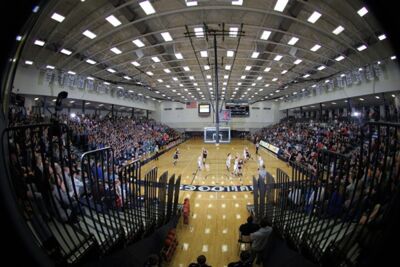
Smith: When I got back here and really got a chance to look at it, it was just incredible. Even going into my 10th year (as AD), I’m still floored that this facility is on our campus. I never take it for granted. There were a lot of people, great athletes and hard-working coaches that wanted the chance to be able to thrive like we’re doing now. They dreamt of that. It’s humbling to have an office, a workspace here and to see student-athletes do some great things.
We’ve had five different schools in my time that have sent people here to visit and to share in ideas of the operational piece of the building and things like what you could do differently and how you manage it. We’ve done presentations at the NAIA Convention on how to manage a facility this size and with this number of people and the processes that go into it to make it effective and efficient. We’ve shared in those capacities. Those five schools have asked for plans or some specific idea about the facility design. They’ve taken it back to their campus and have now started or finished facilities where you see pieces they got from here or from information they may have received from presentations, casual conversations and tours of this place.
Friedrich: It just kind of took my breath away. Thank you Lord for this incredible facility. It was such a game changer for Concordia. It set a whole new bar. For years Concordia had really been a doormat in terms of athletic facilities. We had outstanding coaches, terrific students and great academic programs, but the facilities were not there. This was just one step forward for the growth and expansion of the campus to more truly reflect the excellence and the quality of the faculty and staff here. I’m very, very grateful.
We broke ground for this on a blazing hot day. It was so intensely hot. For Fourth of July (2007) we drew the outline of the facility on the grass. Just walking around the outline, I said, “How big is this thing going to be?” Then we brought Bill Hartmann and some of his equipment so we could do something on the Fourth of July to show people in the community what this was going to be like. A man named Ray Becker who was probably well into his 90s got up on this big bulldozer. He just thought it was fantastic. He got a little hoe that we used to ceremonially break the ground. Then Hartmann gave people rides. Then a few weeks later after the site was pretty well cleared, the board was in town so we did the official groundbreaking. There were some leftover fireworks from the Fourth of July. One of them went off and we had no idea where this thing went. It was great. Only in Seward could you get by with that.
Walz: My first thoughts always are to thank God that this facility is here now. I never say thank you Lord that this building is named after me. That’s not really that important. As far as I’m concerned, to see the facility there, to see our coaches today and student-athletes be able to have those kinds of facilities, I am always filled with thanks that it all became reality and became possible. I think there were four of us who flew to Orange City to look at their new facility. We just all stood there, tongues out saying, “Wow.” We were flying home thinking, “Wouldn’t that be something if Concordia had a place like that?” Today I’m not sure we would trade with anybody.
Olson: I would say our arena is better than 50 percent of Division I and 75 percent of Division II. I’m guessing. I haven’t been in all of them. I feel like there are a lot of Division II’s that have beat up old gyms. We have something that they can’t compete with. It still feels new. We were talking about this at camp this summer. Kelsey Hizer and Dawn Martin come back and help out with our camps. I asked them what their favorite moments were and we started going down memory lane. My biggest one was after we had beaten UNO on the road. I had scheduled this pep rally for after the game. It was more to lead up to CIT and our conference play, but because we had just beaten a Division I team it was perfect timing. We come back and have this awesome pep rally. The place is going bonkers. From that night on of that season the crowd was electric and that started the Interlude dance. Then the 2012 GPAC tournament championship game against Morningside the crowd was coming onto the floor at halftime. That was pretty cool. There are a whole bunch of different memories. I remember big shots. I remember some of the losses like CIT (2013 vs. CU-Ann Arbor), but I think the atmosphere is probably the biggest thing I think about.
Ohlde: The first word that came to mind (when seeing Walz) was awesome. It’s beautiful. It exceeded our expectations. It’s a state-of-the-art facility. I think it’s certainly the best of all facilities of the Concordias and one of the best in the region for schools of that size. I’m really happy with how it turned out and I hope the students aren’t taking it for granted. The combination of the arena with the football stadium and colonnade that’s there now make for such beautiful facilities.
Grasso: This is one of the projects, along with the new Dunklau Center (STEM Building) that we often note when we share the impactful projects we have worked on with all the wonderful people at Concordia University.
Einspahr: A lot of credit goes to Orville Walz, Brian Friedrich, our foundation and board of regents to have the vision to do some of these projects and get our campus updated. There are very few colleges in the entire United States that come anywhere close to the athletic facilities here now. For track and field, it’s a beautiful outdoor facility and right next door is a beautiful indoor facility. I would take our outdoor track over Nebraska’s any day of the week. Ours is very pretty the way it sits down in a bowl … High school kids feel like they’re running in a palace. It’s a great attraction. I know we’ve had a number of coaches take ideas back to their universities and colleges and say that this is a representation of what we would like to do here. I’ve heard that comment made pretty consistently. It’s set up pretty well for track and field.
Schmidt: We wanted to not only make immediate improvement for today, but have the vision and the commitment to build it so that we were making it applicable for 2030, 20 years later. Let’s get this done, but let’s do it right. Let’s make a facility that will still be great 25 years later and 50 years later. I hope they can look back and say, that group that did that really did it right.
Smith: This whole entire sports complex, including the Walz Complex, how it is laid out is so closely knit to the rest of the campus. It really elevated the level of credibility that Concordia University had on the stage of collegiate athletics. I think our student population has been enhanced because they can experience a big-time campus that really thrives. With the Dunklau Center, in addition to Walz, it just shows that we’re progressive and on the cutting edge. Maybe this institution wasn’t prior to the 2000s. It has a lot to do with the leadership of people like President Brian Friedrich and the vision of former President Orville Walz had for athletics and for Concordia University. With a couple more enhancements as I see down the road in the near future, we could have the premier athletic department when it comes to facilities of any college with a student enrollment of 3,000 or less. Looking at different campuses, we have better facilities, a better campus experience and a more pleasing aesthetic campus than many small Division I’s and most Division II’s because of how the campus master plan fits.
